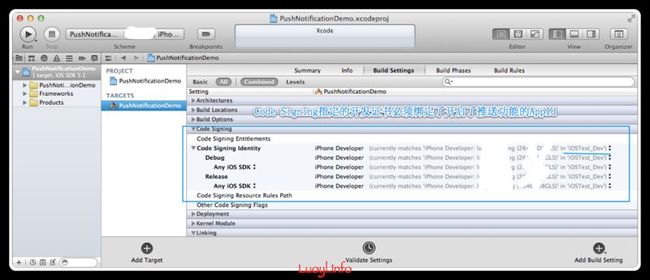一.关于推送通知
来源:http://blog.csdn.net/enuola/article/details/8627283
推送通知,也被叫做远程通知,是在iOS 3.0以后被引入的功能。是当程序没有启动或不在前台运行时,告诉用户有新消息的一种途径,是从外部服务器发送到应用程序上的。一般说来,当要显示消息或 下载数据的时候,通知是由远程服务器(程序的提供者)发送,然后通过苹果的推送通知服务(Apple Push Notification Service,简称apns)推送到设备的程序上。
推送的新消息可能是一条信息、一项即将到期的日程或是一份远程服务器上的新数据。在系统上展现的时候,可以显示警告信息或在程序icon上显示数字,同 时,也可以播放警告音。一旦用户注意到程序有新的信息、时间或是数据,他们可以运行程序并访问新的内容。也可以选择忽略通知,这时程序将不会被激活。
iPhone, iPad和iPod touch上同一时刻只有一个app在前台运行。大多数程序在后台运行的时候,可以对某些用户感兴趣的内容做出回应(定时、或数据等)。推送通知能让程序在这些事件发生的时候通知用户。
作为提供者为程序开发和部署推送通知,必须通过iOS Developer Program Portal获得SSL证书。每个证书限用于一个程序,使用程序的bundle ID作为标识。证书有两种用途的:一种是针对sandbox(用于开发和测试),另外一种针对发布产品。这两种运行环境拥有为各自指定的IP地址并且需要 不同的证书。还必须为两种不同的环境获取各自的provisioning profiles。
APNS提供了两项基本的服务:消息推送和反馈服务。
消息推送:使用流式TCP套接字将推送通知作为二进制数据发送给APNs。消息推送有分别针对开发和测试用的sandbox、发布产品的两个接口,每个都 有各自的地址和端口。不管用哪个接口,都需要通过TLS或SSL,使用SSL证书来建立一个安全的信道。提供者编制通知信息,然后通过这个信道将其发送给 APNs。
注:sandbox: gateway.sandbox.push.apple.com:219
产品接口:gateway.push.apple.com:2195
反馈服务:可以得到针对某个程序的发送失败记录。提供者应该使用反馈服务周期性检查哪些设备一直收不到通知,不需要重复发送通知到这些设备,降低推送服务器的负担。
注:sandbox:feedback.push.apple.com:2196
产品接口:feedback.sandbox.push.apple.com:2196
二.Apple Push Notification的工作机制
从上图,我们可以看到。
- 首先是应用程序注册消息推送。
- IOS跟APNS Server要deviceToken。应用程序接受deviceToken。
- 应用程序将deviceToken发送给PUSH服务端程序(Provider)。
- 服务端程序向APNS服务发送消息。
- APNS服务将消息发送给iPhone应用程序。
无论是iPhone客户端跟APNS,还是Provider和APNS都需要通过证书进行连接的:

图中,
1. Provider是指某个iPhone软件的Push服务器,是我们将要开发的服务器。
2. APNS 是Apple Push Notification Service(Apple Push服务器)的缩写,是苹果的服务器。
上图可以分为三个阶段:
第一阶段:推送服务器(provider)把要发送的消息、目的iPhone的标识打包,发给APNS;
第二阶段:APNS在自身的已注册Push服务的iPhone列表中,查找有相应标识的iPhone,并把消息发到iPhone;
第三阶段:iPhone把发来的消息传递给相应的应用程序,并且按照设定弹出Push通知。
三.开发证书和推送证书的配置
1. 使用开发者帐号登录IOS Provisioning ,选择或新建一个App Id,这里以“info.luoyl.iostest”为例
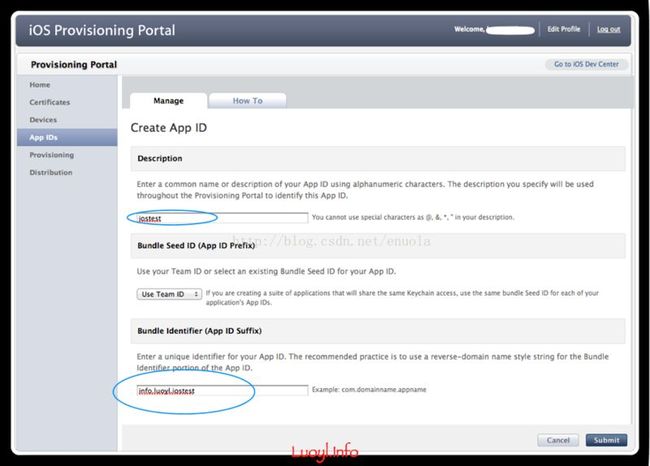
2. 创建完后,进入App Id列表,可以看到新建的App Id默认是没有激活推送功能的,点击Configure链接,进入推送功能激活页面:

3. 在“Enable for Apple Push Notification service”选项上打勾,然后在行点“configure”按钮:
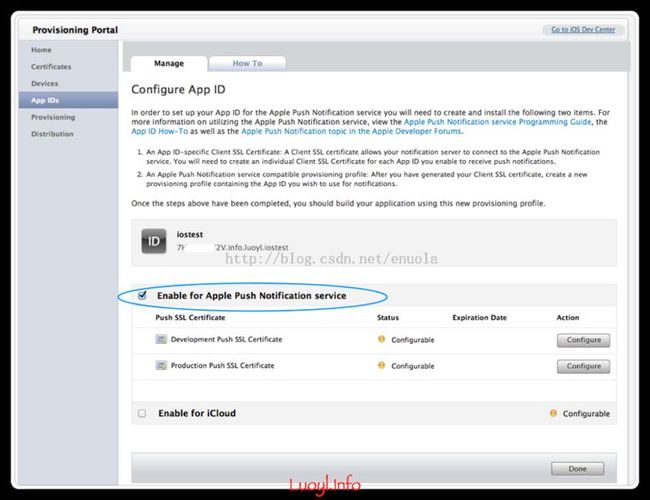
4. 此时会弹出一窗口,点“continue”
5. 弹出证书上传页面,证书选择事先做好的“CertificateSigningRequest.certSigningRequest”,然后点“Generate”按钮;
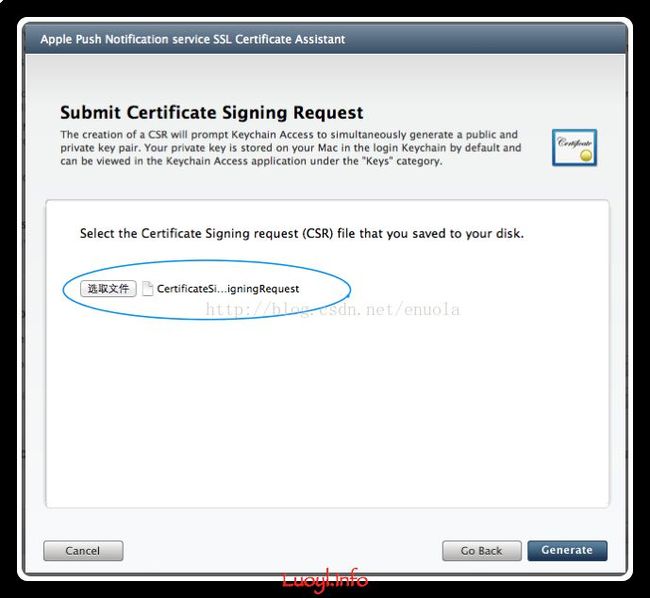
6. 接下来会有“Your APNs SSL Certificate has been generated.”提示,点“continue”:

7. 下载刚生成的证书“aps_development.cer”到电脑:

8. 至此,appid的Development Push SSL Certificate已经变成“Enabled”状态了:

9. 制作一开发者测试证书,appid指定为“info.luoyl.iostest”, 下载后双击安装到电脑上:
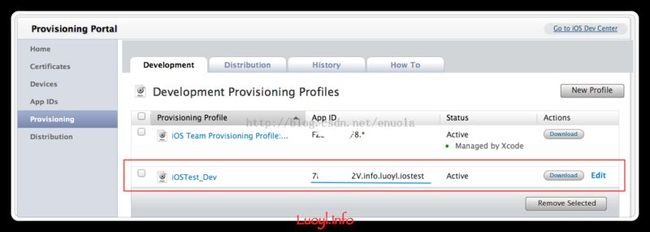
10. 双击在步骤7下载的“aps_development.cer”安装到keychain Access上:

11. 选中push Services证书,右键导出证书为个人信息交换(.p12)格式文件,这里我命名为“aps_development.p12”,点存储时会弹出一个密码设置窗口,可留空不填:
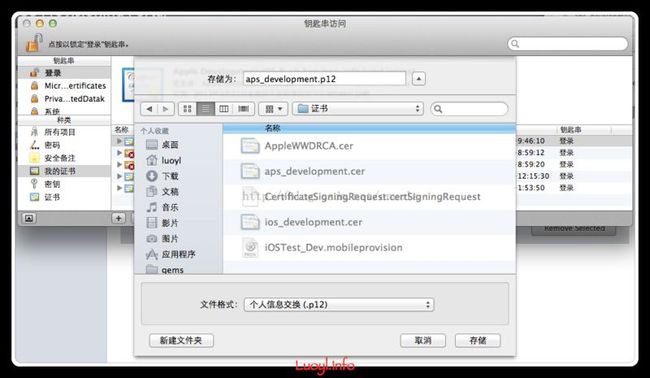
12. 在终端执行下面的命令,把刚才导出的个人信息交换(.p12)格式文件加密转换成推送服务器的推送证书:
- openssl pkcs12 -clcerts -nokeys -out cert.pem -in aps_development.p12
- openssl pkcs12 -nocerts -out key.pem -in aps_development.p12
- openssl rsa -in key.pem -out key.unencrypted.pem
- cat cert.pem key.unencrypted.pem > iostest_push_dev.pem
上面的命令在执行时有4处是需要输入密码的,其中1和2直接回车,3必须设定一个key如“push”,在4处输入3设定的key “push”;
命令执行完后生成的“iostest_push_dev.pem”就是我们推送服务器要使用的推送证书;
经过以上步骤的配置,已经完成了开发推送功能所需要的条件了,接下来将会新建一个ios应用来体验完成推送功能,在ios应用需要实现的接口。
四.开发带有推送功能的IOS应用
为使应用能支持推送功能,我们的项目配置时要注意:
- Bundle Identifier、Code Signing指定的开发证书绑定的AppId要和推送证书绑定的AppId一致(见下图);
- 如 果项目中的开发证书在AppId激活推送功能前已经创建了,这时必须重新生成一个。支持推送功能的开发证书会比旧证书多出一项名为 “aps- environment”的授权串,如果继续使用旧证书,在程序启动尝试注册推送功能时会出现“ 未找到应用程序的“aps-environment”的权利字符串 ”的错误;
- 测试需要用真机,模拟器不支持。
在代码方面,推送的注册、监听和处理都集中在AppDelegate类里:
1.(BOOL)application:(UIApplication *)application didFinishLaunchingWithOptions:(NSDictionary *)launchOptions
在该方法体里主要实现两个功能:
一是完成推送功能的注册请求,即在程序启动时弹出是否使用推送功能;
二是实现的程序启动是通过推送消息窗口触发的,在这里可以处理推送内容;
- - (BOOL)application:(UIApplication *)application didFinishLaunchingWithOptions:(NSDictionary *)launchOptions
- {
- self.window = [[[UIWindow alloc] initWithFrame:[[UIScreen mainScreen] bounds]] autorelease];
- // Override point for customization after application launch.
- self.viewController = [[[ViewController alloc] init] autorelease];
- self.window.rootViewController = self.viewController;
- [self.window setBackgroundColor:[UIColor colorWithPatternImage:[UIImage imageNamed:@"background.png"]]];
- [self.window makeKeyAndVisible];
- /** 注册推送通知功能, */
- [[UIApplication sharedApplication] registerForRemoteNotificationTypes:(UIRemoteNotificationTypeAlert | UIRemoteNotificationTypeBadge | UIRemoteNotificationTypeSound)];
- //判断程序是不是由推送服务完成的
- if (launchOptions) {
- NSDictionary* pushNotificationKey = [launchOptions objectForKey:UIApplicationLaunchOptionsRemoteNotificationKey];
- if (pushNotificationKey) {
- UIAlertView *alert = [[UIAlertView alloc]initWithTitle:@"推送通知"
- message:@"这是通过推送窗口启动的程序,你可以在这里处理推送内容"
- delegate:nil
- cancelButtonTitle:@"知道了"
- otherButtonTitles:nil, nil];
- [alert show];
- [alert release];
- }
- }
- return YES;
- }
2. 接收从苹果服务器返回的唯一的设备token,该token是推送服务器发送推送消息的依据,所以需要发送回推送服务器保存
- - (void)application:(UIApplication *)app didRegisterForRemoteNotificationsWithDeviceToken:(NSData *)deviceToken {
- NSString* token = [NSString stringWithFormat:@"%@",deviceToken];
- NSLog(@"apns -> 生成的devToken:%@", token);
- //把deviceToken发送到我们的推送服务器
- DeviceSender* sender = [[[DeviceSender alloc]initWithDelegate:self ]autorelease];
- [sender sendDeviceToPushServer:token ];
- }
3.接收注册推送通知功能时出现的错误,并做相关处理:
- - (void)application:(UIApplication *)app didFailToRegisterForRemoteNotificationsWithError:(NSError *)err {
- NSLog(@"apns -> 注册推送功能时发生错误, 错误信息:\n %@", err);
- }
4. 接收到推送消息,解析处理
- - (void)application:(UIApplication *)application didReceiveRemoteNotification:(NSDictionary *)userInfo
- {
- NSLog(@"\napns -> didReceiveRemoteNotification,Receive Data:\n%@", userInfo);
- //把icon上的标记数字设置为0,
- application.applicationIconBadgeNumber = 0;
- if ([[userInfo objectForKey:@"aps"] objectForKey:@"alert"]!=NULL) {
- UIAlertView* alert = [[UIAlertView alloc] initWithTitle:@"**推送消息**"
- message:[[userInfo objectForKey:@"aps"] objectForKey:@"alert"]
- delegate:self
- cancelButtonTitle:@"关闭"
- otherButtonTitles:@"处理推送内容",nil];
- alert.tag = alert_tag_push;
- [alert show];
- }
- }
通过上面的代码,基本推送功能的开发已经完成了。最后附件上面代码中所需用到的DeviceSender的类文件,需要将其头文件导入到AppDelegate中。下面是DeviceSender类的.h和.m文件的下载地址:
http://download.csdn.net/detail/enuola/5100134




